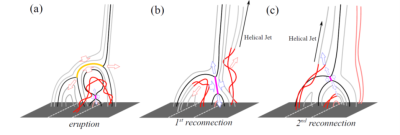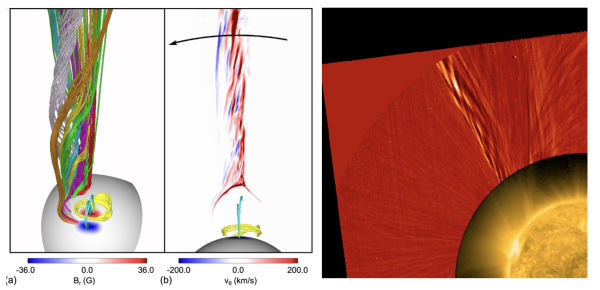Metis observations of Alfvenic outflows driven by interchange reconnection in a pseudostreamer
| Nugget | |
|---|---|
| Number: | 492 |
| 1st Author: | Paolo ROMANO |
| 2nd Author: | the Metis team |
| Published: | April 7, 2025 |
| Next Nugget: | |
| Previous Nugget: | Solar Rollercoaster: looping-the-loop in the solar corona |
Introduction
There is a growing consensus that the so-called Alfvénic wind from coronal holes is due to ubiquitous jetting activity that is observed at the base of the corona. The jets are presumed to result from the [interchange reconnection] between the closed flux of small "parasitic polarity" regions and surrounding coronal-hole open field. High-resolution observations have also revealed that coronal jets are due to the eruption of a filament, just as in large-scale eruptions such as CMEs.
Above a bipolar magnetic region there are open fields of both signs, forming a streamer as seen, for example, during a total eclipse. In the case of a weak parasitic polarity, the bipolar fields all close, resulting in an overlying corona that must be unipolar. Interestingly such a configuration is also often distinguished as a bright coronal ray, given the name "pseudostreamer" because of its different physics.
Metis observations of a wind whirling from the Sun
Metis is the coronagraph on the [1] spacecraft, a space observatory venturing into previously unexplored volumes of the heliosphere.
We report high-cadence Metis observations taken in both unpolarized and polarized visible light on October 12, 2022, during a perihelion passage of Solar Orbiter, that provide new insights into the nature of the intricate coupling between the corona and the solar wind (Ref. [1]). The data show outward propagation of helical features up to 3 solar radii along a radial column that appears to correspond to the stalk of a pseudostreamer. The helical structures persisted for more than 3 hours following a jet-like coronal mass ejection associated with a "polar crown" prominence eruption. We interpret the event in the framework of the "breakout jet model" (Figure 1) and investigate the post-eruption relaxation phase, which exhibits evolving filamentary structures.

For a great view of the data, see the movie, with one frame captured in Figure 2.
Conclusions
Despite a 2-minute time cadence limiting direct correspondence among filamentary structures in consecutive frames, we find that the Metis helical structure may be interpreted as a consequence of twist waves (nonlinear torsional Alfvén waves) and plasma liberated by interchange reconnection. We conjecture that these Metis observations may represent the upper end in spatial and energy scale of the interchange reconnection process that has been proposed recently as the origin of the Alfvénic solar wind.
References
[1] "Metis Observations of Alfvénic Outflows Driven by Interchange Reconnection in a Pseudostreamer"
[2] "The Imprint of Intermittent Interchange Reconnection on the Solar Wind"
